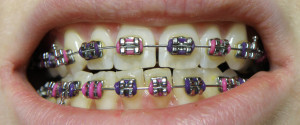6 Ways to Brace for Braces
 I often think how fortunate I am that my parents valued orthodontics when I was a kid. Maybe it was because they, too, had braces growing up. Or perhaps they saw it as a health issue (overcrowded or crooked teeth can prevent good brushing and flossing, strain jaw muscles, and even wear down teeth over time); or, it may have been as simple as wanting my sister and I to have a confident smile later in life. All I know is that as an eleven year old wearing headgear, I wasn’t nearly as grateful as I am now!
I often think how fortunate I am that my parents valued orthodontics when I was a kid. Maybe it was because they, too, had braces growing up. Or perhaps they saw it as a health issue (overcrowded or crooked teeth can prevent good brushing and flossing, strain jaw muscles, and even wear down teeth over time); or, it may have been as simple as wanting my sister and I to have a confident smile later in life. All I know is that as an eleven year old wearing headgear, I wasn’t nearly as grateful as I am now!
As you or your family consider braces and their financial impact, here are a few ways you can better prepare:
Get the Facts
The average time spent on orthodontic work is about 23 months but the longer treatment takes, the more expensive it will be. Kids typically get braces during puberty (though an increasing number of adults are getting braces too, with a 58 percent increase between 1994-2010). Whether for kids or adults, the average costs are usually in the range of $3-7,000, and unfortunately, few insurance companies will cover the cost of treatment. Among the policies that do offer coverage, most only pay out 25%.
Be Aware of Added Costs
If you do opt for braces, be prepared for a few expenses you weren’t counting, or that weren’t included in the original quote (such as a deep cleaning or the replacement of old fillings before treatment begins). Also, be aware that new technologies, like three-dimensional imaging, could dramatically raise your bill.
In terms of more affordable treatment options, traditional, stainless steel braces are most cost-effective while clear, “invisible” or colored braces will cost more. Yes, ceramic models will blend in with your teeth, but they also break more often which means incurring more costs. Lingual braces hide behind your teeth, but require a skillful (and therefore more expensive) orthodontist to install them. Talk to your orthodontist about which braces are going to be right for you.
Finally, to make sure you’re not paying more than you have to, check with the Healthcare Blue Book, a free online guide that gives you an idea of what fair prices are for healthcare services in your area.
Be Prepared to Negotiate
Like dentists or even your doctor, orthodontists will often try to work with you and your budget. They might be able to adjust their services to meet a more affordable price point, or, perhaps they’ll offer monthly payment plans extended beyond the time of treatment (with no interest or other charges). Or, if you can afford it, some offices will offer discounts for paying upfront, particularly if it’s a straightforward treatment.
Seek Out Discounts
If you don’t have dental insurance, try searching for a discount dental plan that covers braces at www.dentalplans.com. You might pay a fee of $100 to $200, but could receive discounts at participating orthodontists from anywhere of 10-60% off (just be sure the plan you sign up for includes the services you’re looking for). Or, investigate college or universities near you with an orthodontics program. Much like dental schools, you can get high-quality care from residents supervised by experienced orthodontists for about two-thirds the cost of a private practice. To find a school near you, visit the the American Association of Orthodontists.
Look for Low-Fee Options
If you’re truly in need, check the website Smiles Change Lives, a nonprofit organization that for a low fee, connects children whose families cannot afford braces with orthodontists willing to provide the service for free.
Don’t Undo the Docs Work
Wear your retainer! Imagine putting in all that time, discomfort and money, just to have your teeth revert back to their original positions. Believe me, it can happen (my slightly misaligned bottom half is now a testament to stopping my retainer regime too early).
Photo Courtesy of: MAKY.OREL




